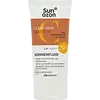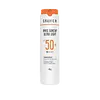What's inside
What's inside
 Key Ingredients
Key Ingredients

 Benefits
Benefits

 Concerns
Concerns

 Ingredients Side-by-side
Ingredients Side-by-side

Water
Skin ConditioningC12-15 Alkyl Benzoate
AntimicrobialGlycerin
HumectantDiisopropyl Adipate
EmollientEthylhexyl Salicylate
UV AbsorberPotassium Cetyl Phosphate
EmulsifyingBis-Ethylhexyloxyphenol Methoxyphenyl Triazine
Skin ConditioningButyl Methoxydibenzoylmethane
UV AbsorberEthylhexyl Triazone
UV AbsorberPhenoxyethanol
PreservativeStearyl Alcohol
EmollientXanthan Gum
EmulsifyingPhenylbenzimidazole Sulfonic Acid
UV AbsorberSilica
AbrasiveTocopheryl Acetate
AntioxidantNiacinamide
SmoothingPotassium Hydroxide
BufferingSclerotium Gum
Emulsion StabilisingAcacia Senegal Gum
MaskingCaprylhydroxamic Acid
Water, C12-15 Alkyl Benzoate, Glycerin, Diisopropyl Adipate, Ethylhexyl Salicylate, Potassium Cetyl Phosphate, Bis-Ethylhexyloxyphenol Methoxyphenyl Triazine, Butyl Methoxydibenzoylmethane, Ethylhexyl Triazone, Phenoxyethanol, Stearyl Alcohol, Xanthan Gum, Phenylbenzimidazole Sulfonic Acid, Silica, Tocopheryl Acetate, Niacinamide, Potassium Hydroxide, Sclerotium Gum, Acacia Senegal Gum, Caprylhydroxamic Acid
Water
Skin ConditioningDimethicone
EmollientEthylhexyl Methoxycinnamate
UV AbsorberButyl Methoxydibenzoylmethane
UV AbsorberButylene Glycol
HumectantOctocrylene
UV AbsorberZinc Oxide
Cosmetic ColorantTitanium Dioxide
Cosmetic ColorantCaprylyl 2-Glyceryl Ascorbate
AntioxidantAscorbyl Glucoside
Antioxidant3-O-Ethyl Ascorbic Acid
Skin ConditioningCarnosine
Skin ConditioningTrimethylsiloxysilicate
EmollientTocopheryl Acetate
AntioxidantBiosaccharide Gum-4
Skin ConditioningTriethoxycaprylylsilane
Sorbitan Isostearate
EmulsifyingPhenoxyethanol
PreservativeHydroxyethyl Acrylate/Sodium Acryloyldimethyl Taurate Copolymer
Emulsion StabilisingAcrylates/C10-30 Alkyl Acrylate Crosspolymer
Emulsion StabilisingVinyl Dimethicone/Methicone Silsesquioxane Crosspolymer
Triethanolamine
BufferingCetearyl Dimethicone Crosspolymer
Lecithin
EmollientChlorphenesin
AntimicrobialDisodium EDTA
Polysorbate 60
EmulsifyingGlycerin
Humectant1,2-Hexanediol
Skin ConditioningAluminum Hydroxide
EmollientStearic Acid
CleansingWater, Dimethicone, Ethylhexyl Methoxycinnamate, Butyl Methoxydibenzoylmethane, Butylene Glycol, Octocrylene, Zinc Oxide, Titanium Dioxide, Caprylyl 2-Glyceryl Ascorbate, Ascorbyl Glucoside, 3-O-Ethyl Ascorbic Acid, Carnosine, Trimethylsiloxysilicate, Tocopheryl Acetate, Biosaccharide Gum-4, Triethoxycaprylylsilane, Sorbitan Isostearate, Phenoxyethanol, Hydroxyethyl Acrylate/Sodium Acryloyldimethyl Taurate Copolymer, Acrylates/C10-30 Alkyl Acrylate Crosspolymer, Vinyl Dimethicone/Methicone Silsesquioxane Crosspolymer, Triethanolamine, Cetearyl Dimethicone Crosspolymer, Lecithin, Chlorphenesin, Disodium EDTA, Polysorbate 60, Glycerin, 1,2-Hexanediol, Aluminum Hydroxide, Stearic Acid
Ingredients Explained
These ingredients are found in both products.
Ingredients higher up in an ingredient list are typically present in a larger amount.
Also known as Avobenzone, this ingredient is a chemical sunscreen filter that provides protection in the UV-A range.
Avobenzone is globally approved and is the most commonly used UV-A filter in the world.
Studies have found that avobenzone becomes ineffective when exposed to UV light (it is not photostable; meaning that it breaks down in sunlight). Because of this, formulations that include avobenzone will usually contain stabilizers such as octocrylene.
However, some modern formulations (looking at you, EU!) are able to stabilize avobenzone by coating the molecules.
Avobenzone does not protect against the UV-B range, so it's important to check that the sunscreen you're using contains other UV filters that do!
The highest concentration of avobenzone permitted is 3% in the US, and 5% in the EU.
Learn more about Butyl MethoxydibenzoylmethaneGlycerin is already naturally found in your skin. It helps moisturize and protect your skin.
A study from 2016 found glycerin to be more effective as a humectant than AHAs and hyaluronic acid.
As a humectant, it helps the skin stay hydrated by pulling moisture to your skin. The low molecular weight of glycerin allows it to pull moisture into the deeper layers of your skin.
Hydrated skin improves your skin barrier; Your skin barrier helps protect against irritants and bacteria.
Glycerin has also been found to have antimicrobial and antiviral properties. Due to these properties, glycerin is often used in wound and burn treatments.
In cosmetics, glycerin is usually derived from plants such as soybean or palm. However, it can also be sourced from animals, such as tallow or animal fat.
This ingredient is organic, colorless, odorless, and non-toxic.
Glycerin is the name for this ingredient in American English. British English uses Glycerol/Glycerine.
Learn more about GlycerinPhenoxyethanol is a preservative that has germicide, antimicrobial, and aromatic properties. Studies show that phenoxyethanol can prevent microbial growth. By itself, it has a scent that is similar to that of a rose.
It's often used in formulations along with Caprylyl Glycol to preserve the shelf life of products.
Tocopheryl Acetate is AKA Vitamin E. It is an antioxidant and protects your skin from free radicals. Free radicals damage the skin by breaking down collagen.
One study found using Tocopheryl Acetate with Vitamin C decreased the number of sunburned cells.
Tocopheryl Acetate is commonly found in both skincare and dietary supplements.
Learn more about Tocopheryl AcetateWater. It's the most common cosmetic ingredient of all. You'll usually see it at the top of ingredient lists, meaning that it makes up the largest part of the product.
So why is it so popular? Water most often acts as a solvent - this means that it helps dissolve other ingredients into the formulation.
You'll also recognize water as that liquid we all need to stay alive. If you see this, drink a glass of water. Stay hydrated!
Learn more about Water